Frequency of Damage of Low Voltage Apparatus Due to Lightning Flashes to Ground Nearby HV Overhead Lines
Abstract
:1. Introduction
- The transfer of overvoltages across the HV-LV transformer and the voltage induced by lightning current in the LV circuit, by using the EMTP-RV transient software.
2. Case Study under Consideration
3. Overvoltages Induced in the HV Line
4. Overvoltages Transfer through HV/LV Transformer
5. Overvoltages Induced in the LV Circuits
6. Apparatus Voltage UA
- The voltage UTR, namely, voltage transferred by the winding of HV/LV transformer which propagates along the LV circuit and is reflected on the terminals of the apparatus, where the condition of open circuit is assumed;
- The voltage drop ΔU along the earthing system between the points where the transformer and the apparatus are earthed;
- The voltage Uind induced by lightning current in the LV circuit downstream the transformer.
- HV line nominal voltage U0 = 20 kV;
- LV apparatus withstand voltage UW = 2.5 kV;
- Apparatus is earthed in the same point as the transformer (apparatus not locally earthed, it is ΔU = 0);
- LV circuit length LC = 50 m;
- Number of LV connected circuits nc = 4;
- HV Line length L = 1 km;
- Ground resistivity ρ = 500 Ωm.
7. LV Apparatus Damage Frequency
- For LV circuits in a multipolar cable, protective measures against overvoltages due to the source of damage S4 are not needed, even in the most severe cases, such as HV lines several km long, soils with resistivity of several hundreds of Ωm, high values of NG, and LV circuits several tens of meters long, powered by HV/LV transformers with primary rated voltage of up to 20 kV; see Figure 12 and Figure 14;
- For LV circuits in conduit, protective measures could be needed, only in the extraordinary case of product NG ·L being not greater than ten and apparatus withstanding voltage UW not lower than 2,5 kV; see Figure 13.
8. Conclusions
- A typical 5/20 µs waveform can be assumed as typical of the UH voltages induced on the HV line; a waveform with a similar rise time also characterizes the UL voltage transmitted to the LV circuits through the HV/LV transformer;
- For values of the voltage UH higher than the withstand voltage UWH at the primary of the transformer, the voltage transmitted to the secondary of the transformer is independent of the length L of the HV line;
- The transfer coefficient CT of overvoltages through an HV/LV transformer, intended as the ratio between the peak values of the voltage UL at the secondary and that UH at the primary (CT = UL/UH), increases with the slope of the wave front of the HV voltage and decreases as the number and the length of the connected LV circuits increase;
- The HV/LV transformer significantly reduces common mode overvoltages: the value of transfer coefficient CT consists of a few percent, or even less if the internal circuit configuration on the LV side is complex;
- Due to times at the peak of the voltage UL, in the order of some microseconds, the propagation coefficient kr along the LV circuit exhibits values close to unity, even for circuits of considerable length;
- The overvoltage stressing the apparatus is mainly due to induction phenomena by the lightning current flowing to ground nearby the HV line; indeed, these overvoltages increase as the area of induction loop (length and width of circuit) increases;
- The frequency of damage of LV apparatus supplied by circuits in multipolar cable is about a thousand times lower than the one relevant to circuits in plastic conduit;
- The frequency of damage of the LV apparatus increases weakly as the HV line nominal voltage increases;
- For a tolerable frequency of damage of reasonable value, the use of protection measures of the LV apparatus against overvoltages caused by the source S4 is practically not necessary. Exceptional cases of long circuits in conduit, powered by long HV overhead lines in areas with high NG values, are usually covered by the LV SPDs installed for protection against overvoltages due to sources S1 and S3.
Author Contributions
Funding
Acknowledgments
Conflicts of Interest
References
- IEC 62305-1; Protection against Lightning—Part 1: General Principles. 2nd ed. IEC: Geneva, Switzerland, 2010.
- IEC 62305-4; Protection Against Lightning—Part 4: Electrical and Electronic Systems within Structures. 2nd ed. IEC: Geneva, Switzerland, 2010.
- Marzinotto, M.; Fiamingo, F.; Mazzetti, C.; Lo Piparo, G.B. Quality of the supplied electric service: A tool to evaluate the need of protection against lightning surges. Electr. Power Syst. Res. 2012, 85, 75–81. [Google Scholar] [CrossRef]
- Kisielewicz, T.; Lo Piparo, G.B.; Napolitano, F.; Mazzetti, C.; Nucci, C.A. SPD dimensioning in front of indirect flashes to overhead low voltage power lines. In Proceedings of the 15 IEEE International Conference on Environment and Electrical Engineering, Rome, Italy, 10–13 June 2015. [Google Scholar]
- Kisielewicz, T.; Lo Piparo, G.B.; Mazzetti, C. Simplified approach for protection of apparatus powered by an HV/LV transformer against lightning strokes to the structure. In Proceedings of the 22 IEEE International Conference on Environment and Electrical Engineering, Prague, Czech Republic, 28 June–1 July 2022. [Google Scholar]
- Piantini, A.; Janiszewski, J.M. An experimental study of lightning induced voltages by means of a scale model. In Proceedings of the 21st International Conference on Lightning Protection, Berlin, Germany, 22–25 September 1992. [Google Scholar]
- Rachidi, F.; Nucci, C.A.; Ianoz, M. Transient analysis of multiconductor lines above a lossy ground. IEEE Trans. Power Deliv. 1999, 14, 294–302. [Google Scholar] [CrossRef]
- Rachidi, F.; Loyka, S.L.; Nucci, C.A.; Ianoz, M. On the Singularity of the Ground Transient Resistance of Overhead Transmission Lines. In Proceedings of the 25th International Conference on Lightning Protection, Rhodos, Greece, 18–22 September 2000. [Google Scholar]
- Porrino, A.; Alexandri, I.; Clement, M.; Finlay, G.S.; Henriksen, T.; Hoeffelman, J.; Ishii, M.; Martinez Cid, P.; Nucci, C.A.; Po-polansky, F.; et al. Protection of MV and LV networks against lightning. I. Basic information, Electricity Distribution. Part 1: Contributions. CIRED. In Proceedings of the 14th International Conference and Exhibition on (IEE Conf. Publ. No. 438), Birmingham, UK, 2–5 June 1997; pp. 21/1–21/7. [Google Scholar]
- Eriksson, A.J. The incidence of lightning strikes to power lines. IEEE Trans. Power Deliv. 1978, 2, 859–870. [Google Scholar] [CrossRef]
- Kisielewicz, T.; Lo Piparo, G.B.; Mazzetti, C. Simplified evaluation of damage probability of apparatus powered by an HV/LV transformer due to lightning strokes to the overhead line. In Proceedings of the 22 IEEE International Conference on Environment and Electrical Engineering, Prague, Czech Republic, 28 June–1 July 2022. [Google Scholar]
- IEEE Standard 1410; IEEE Guide for Improving the Lightning Performance of Electric Power Overhead Distribution Lines. IEEE: New York, NY, USA, 2011.
- CIGRE-CIRED JWG C4.4.02; Protection of MV and LV Networks against Lightning. Part I: Common Topics. International Council of Large Electric Systems (CIGRE): Paris, France, 2006.
- Nucci, C.A. The lightning induced over-voltage (LIOV) code. In Proceedings of the 2000 IEEE Power Engineering Society Winter Meeting, Singapore, 23–27 January 2000; 2000; Volume 4, pp. 2417–2418. [Google Scholar]
- Rachidi, F.; Janischewskyj, W.; Hussein, A.M.; Nucci, C.A.; Guerrieri, S.; Kordi, B.; Jen-Shih, C. Current and electromagnetic field associated with lightning-return strokes to tall towers. IEEE Trans. EMC 2001, 43, 356–367. [Google Scholar] [CrossRef]
- Rusck, S. Induced lightning overvoltages on power transmission lines with special reference to the overvoltage protection of low voltage networks. Trans. R. Inst. Technol. Stockh. 1958, 120, 1–123. [Google Scholar]
- Rusk, S. Protection of distribution systems. In Lightning; Golde, R.H., Ed.; Academic Press: New York, NY, USA, 1977; Volume 2. [Google Scholar]
- Nucci, C.A.; Rachidi, F.; Ianoz, M.; Mazzetti, C. Lightning-induced overvoltages on overhead lines. IEEE Trans. EMC 1993, 35, 75–86. [Google Scholar]
- Nucci, C.A.; Rachidi, F. On the contribution of the electromagnetic field components in field-to-transmission lines interaction. IEEE Trans. EMC 1995, 37, 505–508. [Google Scholar] [CrossRef] [Green Version]
- Nucci, C.A.; Guerrieri, S.; Correia de Barros, M.T.; Rachidi, F. Influence of Corona on the voltages induced by nearby lightning on overhead distribution lines. IEEE Trans. PD 2000, 15, 1265–1273. [Google Scholar]
- Cooray, V. Horizontal fields generated by return strokes. Radio Sci. 1992, 27, 529–537. [Google Scholar] [CrossRef]
- Popolansky, F. Measurement of lightning currents in czechoslovakia and the application of obtained parameters in the prediction of lightning outages of ehv transmission lines. In Proceedings of the Conference International des Grands Électriques Réseaux Haute Tension, Paris, France, 24 August–2 September 1970. [Google Scholar]
- Goedde, G.L.; Kojovic, L.j.A.; Woodworth, J.J. Surge arrester characteristics that provide reliable overvoltage protection in distribution and low-voltage systems. In Proceedings of the IEEE Power Engineering Society Transmission and Distribution Conference, Seattle, WA, USA, 16–20 July 2000. [Google Scholar]
- Milardić, V.; Uglesic, I.; Pavić, I. Selection of surge protective devices for low-voltage systems connected to overhead line. IEEE Trans. Power Deliv. 2010, 25, 1530–1537. [Google Scholar] [CrossRef]
- IEC 60364-5; Electrical Installations of Buildings. 3rd ed. IEC: Geneva, Switzerland, 2001.
- Nucci, C.A.; Borghetti, A.; Piantini, A.; Janiszewski, J.M. Lightning-induced voltages on distribution overhead lines: Comparison between experimental results from a reduced-scale model and most recent approaches. In Proceedings of the 24th International Conference on Lightning Protection, Birmingham, UK, 14–18 September 1998. [Google Scholar]
- IEC 61643-11; Low-voltage surge protective devices—Part 11: Surge protective devices connected to low-voltage power systems—Requirements and test methods. 1st ed. IEC: Geneva, Switzerland, 2011.
- Kisielewicz, T.; Lo Piparo, G.B.; Fiamingo, F.; Mazzetti, C.; Kuca, B.; Flisowski, Z. Factors affecting selection, installation and coordination of surge protective devices for low voltage systems. Electr. Power Syst. Res. 2014, 113, 220–227. [Google Scholar] [CrossRef]
- Kisielewicz, T.; Mazzetti, C.; Lo Piparo, G.B.; Fiamingo, F. Stress to SPD system due to direct flashes to LV lines. Electr. Power Syst. Res. 2015, 129, 44–50. [Google Scholar] [CrossRef]
- Bassi, W.; Matsuo, N.M.; Piantini, A. Currents and charge absorbed by low-voltage SPDs in overhead distribution systems due to lightning. In Proceedings of the Eleventh International Symposium on High Voltage Engineering (Conf. Publ. No. 467), London, UK, 23–27 August 1999. [Google Scholar]
- Wang, S.; He, J. Discussion on worst distance between spd and protected device. IEEE Trans. Electromagn. Compat. 2011, 53, 1081–1083. [Google Scholar] [CrossRef]
- He, J.; Yuan, Z.; Wang, S.; Hu, J.; Chen, S.; Zeng, R. Effective protection distances of low-voltage SPD with different voltage protection levels. IEEE Trans. Power Deliv. 2010, 25, 187–195. [Google Scholar]
- Li, C.; He, J.; Yu, Z.; Yuan, Z.; Wang, S.; Hu, J.; Zeng, R.; Chen, S. Effective protection distances of SPDs for household electrical appliances. IEEE Trans. Electromagn. Compat. 2011, 53, 690–699. [Google Scholar]
- Metwally, I.A.; Heidler, F. Enhancement of the SPD Residual Voltage at Apparatus Terminals in Low-Voltage Power Systems. IEEE Trans. Power Deliv. 2007, 22, 2207–2213. [Google Scholar] [CrossRef]
- Piantini, A.; Duarte, D.M.; Romero, F. Lightning Overvoltages on Rural Distribution Lines. In Proceedings of the International Conference on High Voltage Engineering and Application, ICHVE, Chongqing, China, 9–12 November 2008. [Google Scholar]
- Hileman, A. Insulation Coordination for Power Systems; Marcel Dekker, Inc.: New York, NY, USA, 1999. [Google Scholar]
- Braz, C.P.; Piantini, A.; Shigihara, M.; Ramos, M.C.E.S. Analysis of the disruptive effect model for the prediction of the breakdown characteristics of distribution insulators under non-standard lightning impulses. In Proceedings of the International Conference on Lightning Protection, Vienna, Austria, 2–7 September 2012. [Google Scholar]
- Grcev, L. Modeling of grounding electrodes under lightning currents. IEEE Trans. Electromagn. Compat. 2009, 51, 559–571. [Google Scholar] [CrossRef]
- Mata, C.T.; Rakov, V.A.; Rambo, K.J.; Diaz, P.; Rey, R.; Uman, M.A. Measurement of the division of lightning return stroke current among the multiple arresters and grounds of a power distribution line. IEEE Trans. Power Deliv. 2003, 18, 1203–1208. [Google Scholar] [CrossRef]
- Borghetti, A.; Morched, A.S.; Napolitano, F.; Nucci, C.A.; Paolone, M. Lightning-induced overvoltages transferred through distribution power transformers. IEEE Trans. Powery Deliv. 2009, 24, 360–372. [Google Scholar] [CrossRef]
- Piantini, A.; Kanashiro, A.G. A distribution transformer model for calculating transferred voltage. In Proceedings of the International Conference on Lightning Protection, Cracow, Poland, 2–6 September 2002. [Google Scholar]
- Kisielewicz, T.; Lo Piparo, G.B.; Mazzetti, C.; Fiamingo, F. Factors influencing the probability of an apparatus damage in an extended earthing arrangement. In Proceedings of the International Conference on Lightning Protection 2016, Estoril, Portugal, 25–30 September 2016. [Google Scholar]
- Lo Piparo, G.B.; Kisielewicz, T.; Mazzetti, C.; Fiamingo, F. Protection of apparatus against lightning surge in an extended earthing arrangement. In Proceedings of the 16 IEEE International Conference on Environment and Electrical Engineering, Florence, Italy, 7–10 June 2016. [Google Scholar]
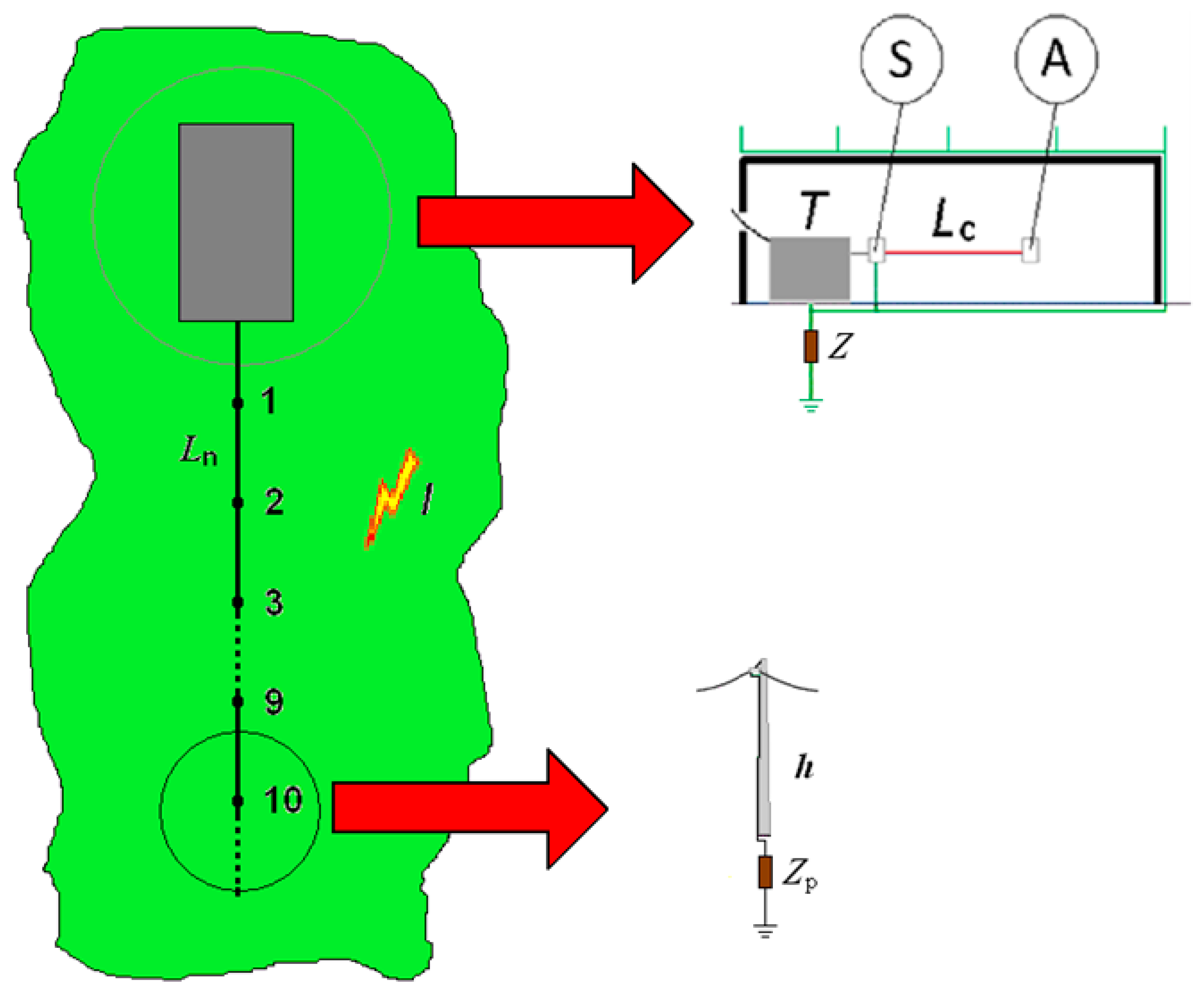

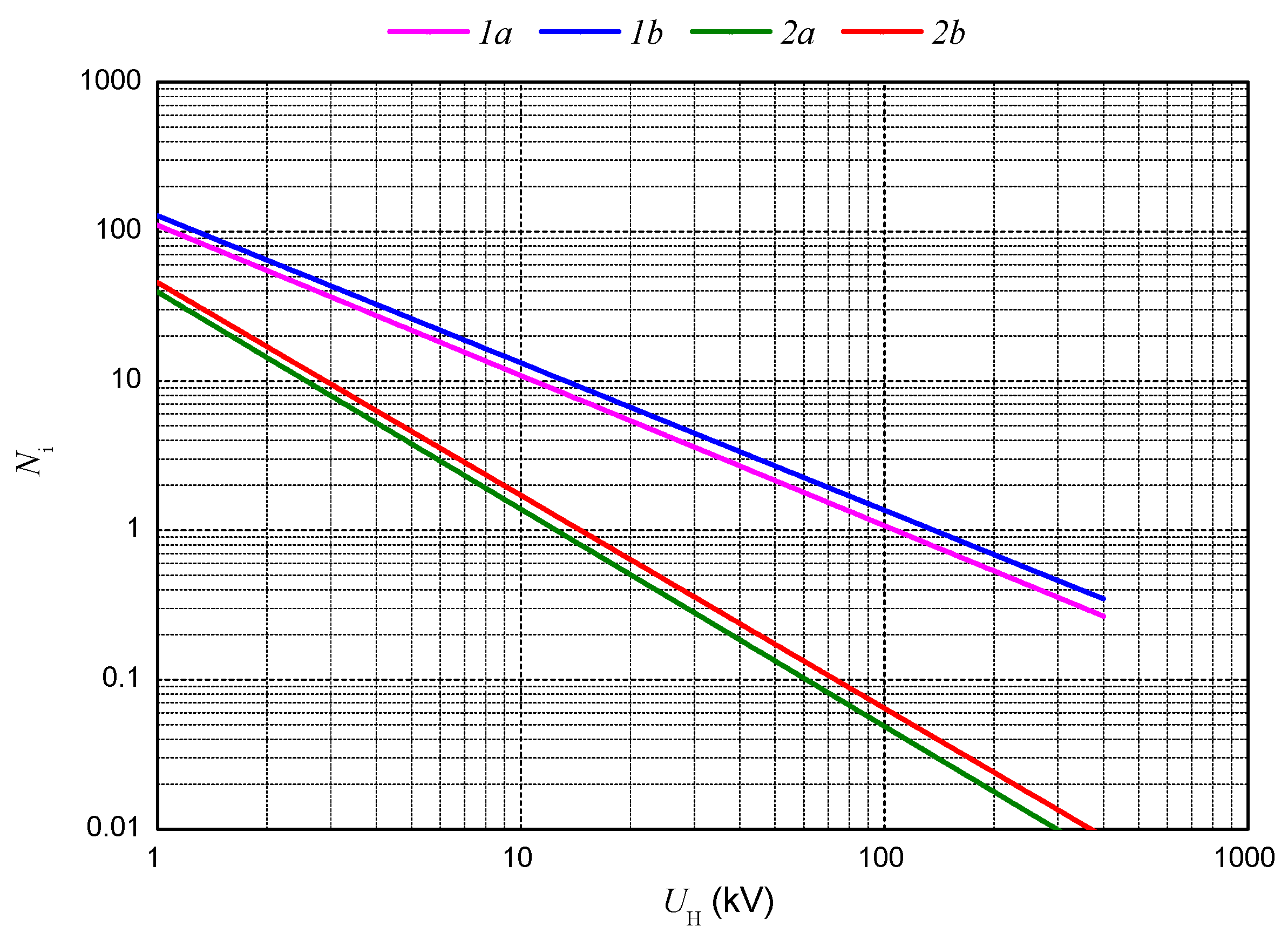


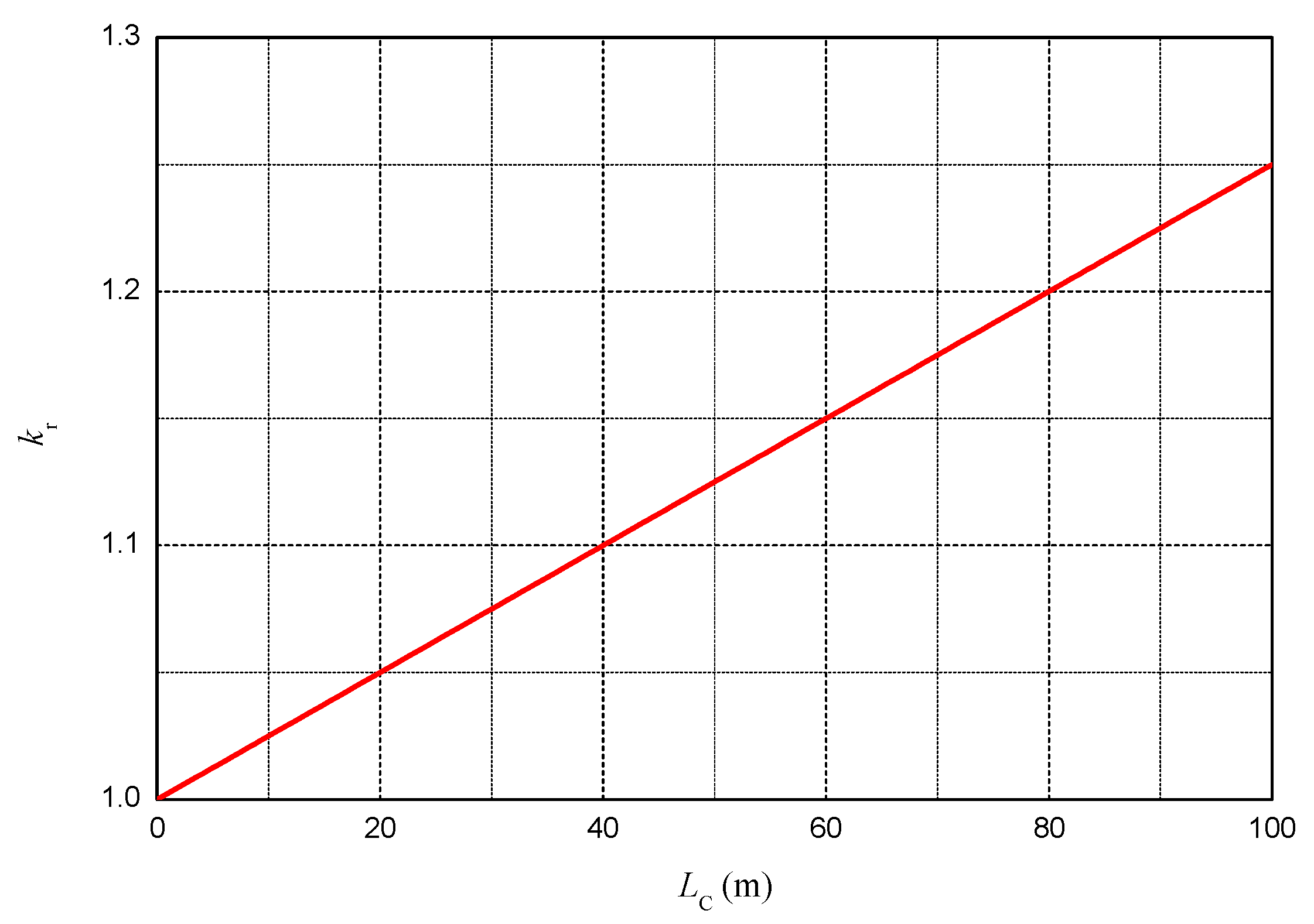




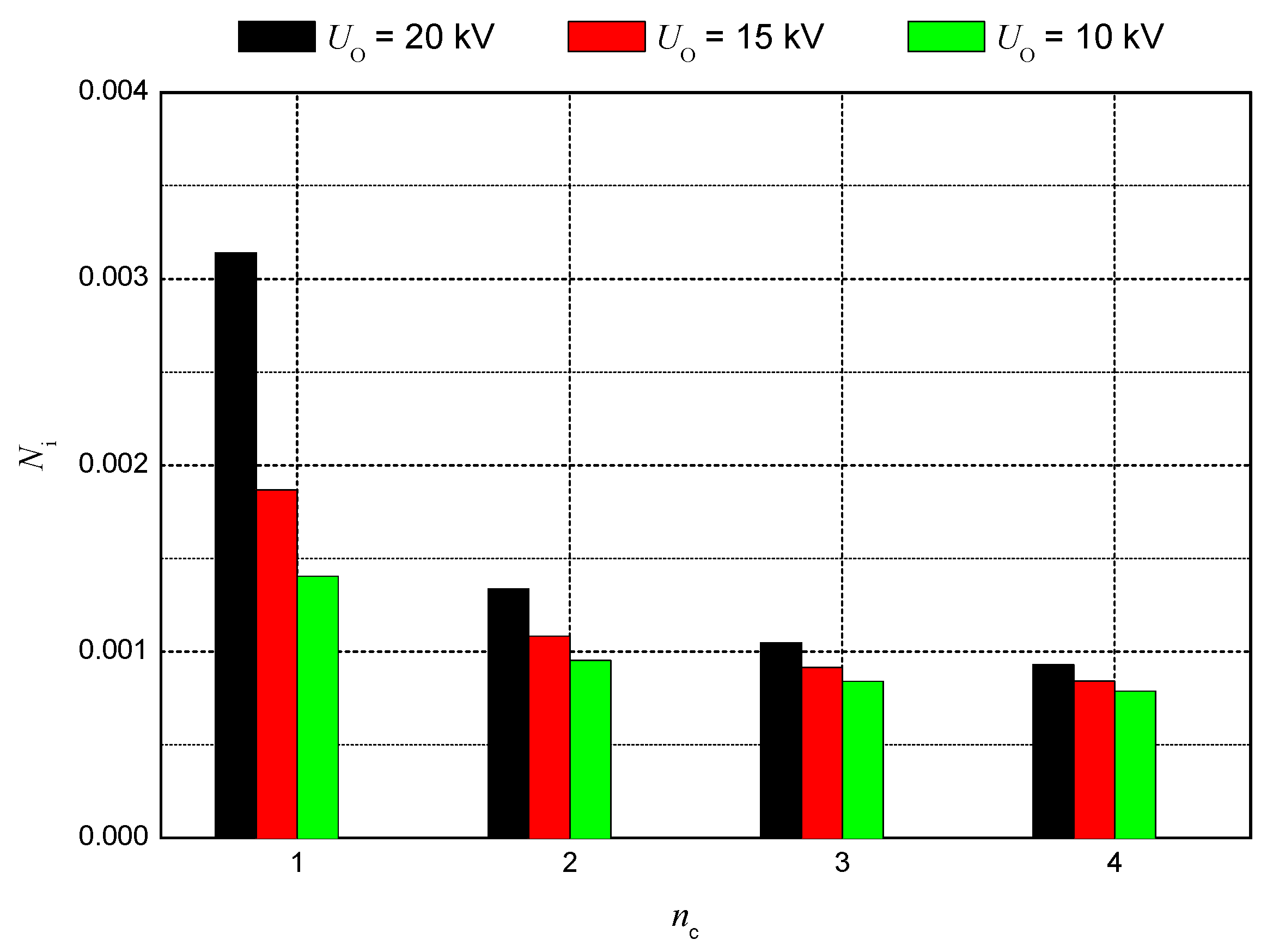
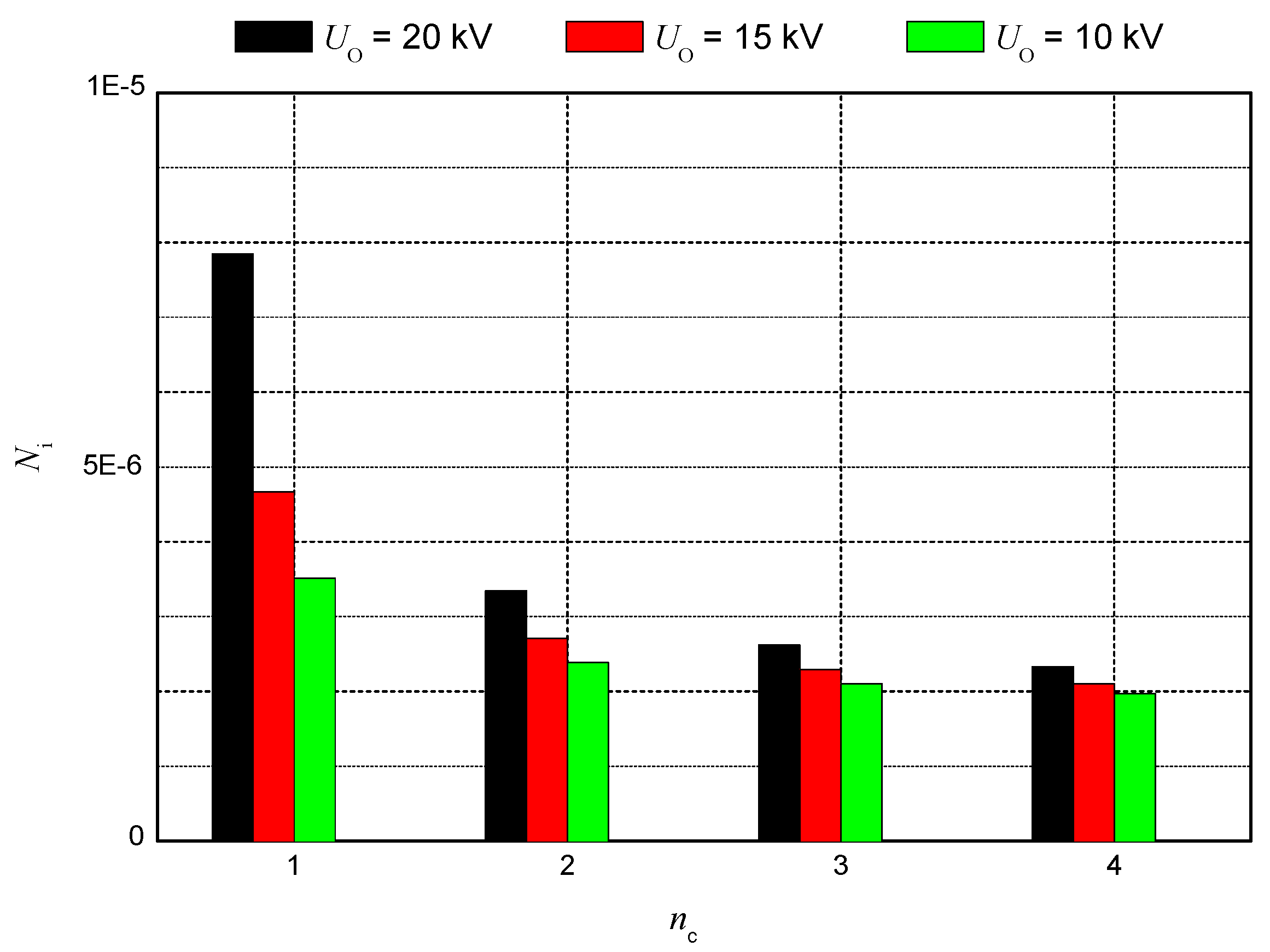


Publisher’s Note: MDPI stays neutral with regard to jurisdictional claims in published maps and institutional affiliations. |
© 2022 by the authors. Licensee MDPI, Basel, Switzerland. This article is an open access article distributed under the terms and conditions of the Creative Commons Attribution (CC BY) license (https://creativecommons.org/licenses/by/4.0/).
Share and Cite
Kisielewicz, T.; Piparo, G.B.L.; Mazzetti, C. Frequency of Damage of Low Voltage Apparatus Due to Lightning Flashes to Ground Nearby HV Overhead Lines. Energies 2022, 15, 7809. https://doi.org/10.3390/en15207809
Kisielewicz T, Piparo GBL, Mazzetti C. Frequency of Damage of Low Voltage Apparatus Due to Lightning Flashes to Ground Nearby HV Overhead Lines. Energies. 2022; 15(20):7809. https://doi.org/10.3390/en15207809
Chicago/Turabian StyleKisielewicz, Tomasz, Giovanni Battista Lo Piparo, and Carlo Mazzetti. 2022. "Frequency of Damage of Low Voltage Apparatus Due to Lightning Flashes to Ground Nearby HV Overhead Lines" Energies 15, no. 20: 7809. https://doi.org/10.3390/en15207809
APA StyleKisielewicz, T., Piparo, G. B. L., & Mazzetti, C. (2022). Frequency of Damage of Low Voltage Apparatus Due to Lightning Flashes to Ground Nearby HV Overhead Lines. Energies, 15(20), 7809. https://doi.org/10.3390/en15207809




